| Educating Freedmen During Reconstruction in Fairfax County |
||||||||||||||||||||||||||||
|
by Debbie Robison December 6, 2014 | ||||||||||||||||||||||||||||
|
In 1865 the Bureau of Refugees, Freedmen and Abandoned Lands (Freedmen’s Bureau) conducted a census of African Americans living in Fairfax County and found that of the 2,941 people listed, 128 were able to read.[1] It is likely that many of those who could read were free before the Civil War. Although Virginia made it illegal in 1819 for slaves to meet at schools to learn to read and write, it wasn’t until 1831 that this restriction extended to free blacks.[2] African Americans in Fairfax County began obtaining educational instruction prior to the end of the Civil War. Most of the schools established in the mid–to–late 1860s were formed as a cooperative effort between the Freedmen’s Bureau, who supplied materials and funds to build the schools, the Friends’ Association (of Philadelphia) for the Aid and Elevation of the Freedmen, who supplied teachers and books, and the freedmen who provided labor to build the schools and, when possible, funds to purchase school lots and assist in paying teacher salaries. Congress established the Freedmen’s Bureau as part of the War Department on March 3, 1865.[3] 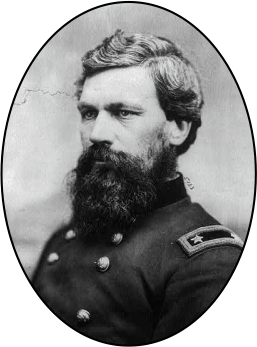
Maj. Gen. Oliver Otis Howard, Commissioner of the Freedmen’s Bureau, ordered assistant commissioners to appoint an officer in each state to serve as Superintendent of Schools. Superintendents were instructed to supervise the education of refugees and freedmen, secure protection for schools and teachers, aid in maintaining schools, and correspond with benevolent societies in securing teachers to staff schools. Rev. John Kimball was appointed Superintendent of Education for the District of Columbia in August 1865. His district included Fairfax County until responsibility for the County transferred to the Superintendent of Education for Virginia in 1867. The Freedmen’s Bureau employees who had the greatest impact, however, were the assistant superintendents stationed in Fairfax County who worked with freedmen and residents to establish schools. Maj. General Oliver Otis Howard | ||||||||||||||||||||||||||||
|
From 1864 to 1868, fifteen schools were established in Fairfax County for freedmen that were supported, in one way or another, by the Freedmen’s Bureau. [4] There were also private schools in the Gum Springs area, in Falls Church, and possibly at Springfield and Burkes Station. | ||||||||||||||||||||||||||||
The Freedmen’s Bureau recommended new school locations and administered the schools. Teachers were required to submit monthly reports that enumerated school statistics, such as the number of students, average attendance, and the number of students who could read, write, and solve arithmetic problems. The number of students studying geography and needlework was also reported.[5] | ||||||||||||||||||||||||||||
| CONTRABAND CAMP SCHOOLS | ||||||||||||||||||||||||||||
|
Some of the first schools established in Fairfax County for former slaves were located in contraband camps, which were established by the federal government to provide shelter and aid to freedmen who, having escaped bondage, travelled to the area for the protection and support of the army. The term “contraband” referred to slaves who fled to freedom during the war. By September 1864 two teachers were engaged by the Friends’ Association (of Philadelphia) for the Aid and Elevation of the Freedmen to teach in schools at Camp Wadsworth located near present-day McLean, Virginia.[6] Camp Wadsworth was established on two farms. Lydia T. Atkinson taught school at the upper farm and Mary McLain taught school at the lower farm.[7] When representatives of the Friends’ Association visited Camp Wadsworth in December 1864, they found that there were few students due a government policy to bind out children of a suitable age in homes. Many parents didn’t wish to be parted from their children and left the camp. They also observed that although the farm superintendent constructed a cabin for Mary McLain, it was very small and not expected to protect her well during the winter weather due to its loose construction. [8] The land at Camp Wadsworth was returned to the former owners in March 1866 and the schools closed. [9] | ||||||||||||||||||||||||||||
| EARLY PRIVATE SCHOOLS | ||||||||||||||||||||||||||||
|
Private School Near
Gum Springs African Americans living in the Accotink and Gum Springs area had established their own private school sometime prior to June 1865, as noted in a report by a representative of the Freedman’s Bureau. In June 1865 George P. Carse surveyed the Accotink and Gum Springs area to determine if the region was suitable for relocating freedmen onto small farms. In his report, Carse recommended that two or more schools be established there. [10] However, Carse found that African Americans here were already operating a private school. Samuel K. Lee, whom Carse described as a very intelligent colored man who bought his freedom before the war, owned a small house and lot that he allowed to be used as a school house for the colored children in the neighbourhood. On June 8, 1865 the house was set on fire and burned to the ground. Carse reported that it was believed to have been set on fire by some malicious white person to prevent the colored children being educated. The school moved to the house of Charles Ford near Gum Springs.[11] Mission School at
Falls Church In 1863, Betsy Read started a Sabbath school in Falls Church that expanded to add a day school teaching freedmen to read, spell, and write cipher. The day school was started at the encouragement of a Dr. Johnson who paid Miss Read one month’s salary. The room where the school was held was located in a house where an African American woman lived, though the exact location in Falls Church is unknown. When enrollment in the school increased to 50 to 60 students, Miss Read was assisted by her sister and her father, John D. Read. Due to overcrowding in the school room, students used slates instead of paper since there wasn’t enough space for desks.[12] In October 1864, John D. Read was taken from his home by a squad of Mosby’s guerillas and killed in a pine woods near Hunter’s Mill. It was thought that he was killed as a consequence of his helping the freedmen.[13] As a result of her father’s death, Betsy Read no longer wished to teach school; however, Rev. Hirim W. Read, brother of John D. Read, continued the school. The school, known as the Mission School, may have received its name due to Rev. Read being a Baptist missionary. Rev. Read gained the support of Rev. D. W. Anderson, pastor of the 19th Street Baptist Church, a church located in Washington, D.C serving the surrounding African American community. In November 1867, Anderson arranged for Read to receive lumber from the Freedmen’s Bureau for repairs to the mission school.[14] | ||||||||||||||||||||||||||||
| SCHOOL AT FAIRFAX COURT HOUSE | ||||||||||||||||||||||||||||
|
Several attempts were made to establish a school for the freedmen’s children at Fairfax Court House, now known as the City of Fairfax, before the Freedmen’s Bureau achieved long-term success there. The first school opened in the basement of a private home where the students were taught by two Union soldiers. [15] 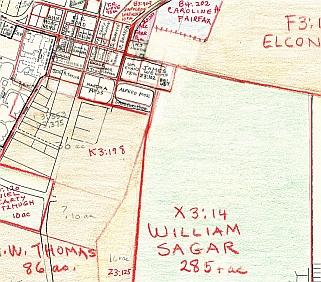
In August 1865, Capt. George Armes, who was then an Assistant Superintendent of the Freedmen’s Bureau, arranged for freedmen to live in former block houses at Fairfax Court House: one located on Henry W. Thomas’s land and the other on Mr. Sagar’s land. Additional lumber was requested for building more housing. The availability of housing may have contributed to a concentration of school-age children at Fairfax Court House. A committee sent Capt. Armes a list of 100 children who were large enough to attend school. Armes suggested using a store house located on a county lot as a school house.[16] It is unknown if the store house was ever used as a school. Map depicting land ownership in 1860 shows location of Thomas’s and Sagar’s land, Created by Beth Mitchell, Image Courtesy Fairfax County History Commission and the Fairfax County Circuit Court Archives.[17] In September 1865, Armes wanted to use brick taken from Mr. Love’s farm buildings to construct chimneys for the freedmen’s houses and school houses.[18] There is no evidence that he was successful in establishing a school or building chimneys because later that month, when a new Assistant Superintendent was installed, there weren’t any schools at Fairfax Court House. 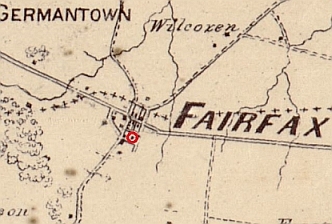
On September 25, 1865 Lieutenant Sidney B. Smith, who had recently been appointed Assistant Superintendent in the Freedmen’s Bureau for the district that included Fairfax County, expressed a desire to open a school at Fairfax Court House where his headquarters was located. He sent a letter asking how he could obtain books for scholars who were just beginning.[19] Soon thereafter, he established a school in the basement of Mrs. Moss’s house. Fifty students were taught by two soldiers, part of a detachment of the 195th Ohio Volunteer Infantry that was sent to Smith at Fairfax Court House.[20] A Sabbath school, attended by old and young alike, was established in conjunction with the school; however, the school did not last long.[21] When Smith’s headquarters was relocated to Vienna on October 2, 1865, the house where the school was taught was returned to the owner and the school closed.[22] Location of Mrs. Moss’s House, shown on an 1843 plat of Fairfax Court House. Image courtesy Library of Congress[23] | ||||||||||||||||||||||||||||
| VISIT BY THE FRIENDS’ ASSOCIATION TO ESTABLISH SCHOOLS | ||||||||||||||||||||||||||||
|
The Friends’ Association was a religious organization that solicited
subscriptions and donations of money, dry goods, cast-off clothing, etc. to be
used for the benefit of the freedmen. The money paid teacher salaries and
purchased school books.[24]
Several teachers requested donations of clothing from the Friends’ Association
since some children couldn’t attend school without it, especially during the
cold season.[25] The Friends’ Association may have decided to increase their efforts in Fairfax County as a result of an article placed in The Nation, a news publication in New York. In December 1865, The Friends’ Intelligencer, a weekly news magazine, republished a letter printed in The Nation from Lieutenant Smith, the Freedmen’s Bureau Assistant Commissioner for Fairfax County. Smith reported that: | ||||||||||||||||||||||||||||
|
There is not a school
in the county, although there are one hundred and thirty five freedmen in the
vicinity of Fairfax Court-House, fifty at the station, and the same number at
Lewinsville. The behavior of the
people is in every way exemplary, and few cases of oppression have come to his
notice. Education is the greatest want.[26] | ||||||||||||||||||||||||||||
|
The Friends’ Association decided to place eleven teachers in southern schools for African-American students; however, they found it difficult to obtain the information they needed before sending female teachers away from their homes. [27] In March 1866, Jacob M. Ellis, a member of the Education Committee, traveled to Fairfax County to advance the interests of the Association. He was accompanied by Mary McBride, one of the women engaged as a teacher. In Vienna, Ellis met with Captain James A. Ross, the local assistant superintendent for the Freedmen’s Bureau whom Ellis had been in correspondence with prior to the trip. Their first meeting to discuss the needs and existing facilities in Fairfax County was very discouraging; however, Ross offered to accompany Ellis anywhere the next day and to do what he could to establish schools.[28] Jacob Ellis and Mary McBride first visited Fairfax Station, a place that Ellis felt was not an acceptable location for a teacher. | ||||||||||||||||||||||||||||
|
The next morning, “Fairfax Station,” some nine miles distant, was first visited, and desolation is a tame word to define its condition. It is simply a station house and small store combined, with several colored families scattered round in log shanties, and some Irish families herding under a hill some distance off. The building appropriated for a school was all well enough, but I could not conscientiously ask any lady to locate there with all the repulsive surroundings, neither would I be willing to leave her there, upon her cheerfully proffering so to do. — Jacob M. Ellis[29] | ||||||||||||||||||||||||||||
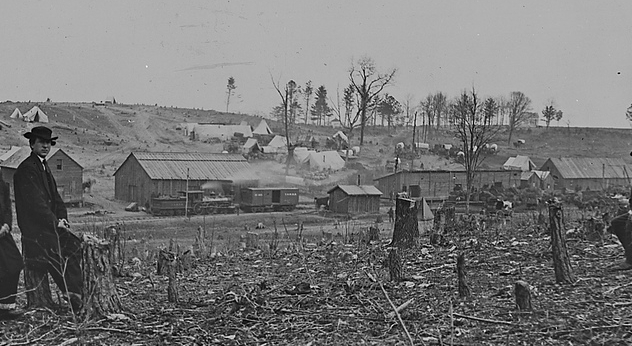
Fairfax Station During
the Civil War, Matthew Brady Photographer, Image Courtesy National Archives and
Records Administration Captain Ross suggested that he could have the building moved to someplace near Fairfax Courthouse, provided that Ellis could find a lot for the school and board for the teacher. They didn’t hold out much hope, though, since the opinion had always been that it would be almost impossible to establish a school there for black children due to the rebellious spirit of the residents. They first applied to an Englishman who operated a boarding school there. Although he offered excuses why he wouldn’t take the teacher as a boarder, he gave the names of two or three Union supporters in the neighborhood. One was the postmaster. He was very interested in their undertaking, but could not take in a boarder due to his family situation. He did extend an invitation for the teacher assigned to the area to socialize with his family. Ellis had luck with the third person they met, a widow who was willing to board the teacher.[30] The next day a site was selected for the school east of Fairfax Court House on the turnpike. The ground belonged to Mr. Sagar, a Union man who, impoverished due to the war, received a small rent from the Friends’ Association for the use of the lot. Although the spot was barren, there was shade available nearby. In March 1866, the building at Fairfax Station was dismantled, conveyed to the lot, and rebuilt as a school.[31] It was expected to be open by April 1866, soon after the opening of the Vienna school. Mary McBride became the teacher. [32] The school house was described as a substantial one measuring 16 feet wide by 25 feet long and built of hewn logs. When repairs were made to the school in November 1866, Capt. James Ross requested 1,500 ft plank, 200 ft of scantling, and 8 window sash and glass.[33] The school house was owned by the freedmen since the building was given to them by the Freedmen’s Bureau. In time, the freedmen came to disagree about whether the
school should be moved to a different location. Many felt that it should be
located about one mile south of the court house instead of 1/4 mile east of the
court house, which was its original location. Mr. Sagar was willing to have the
school house remain on his land if the people who wanted to move it couldn’t
obtain the funds to purchase a new lot.[34]
| ||||||||||||||||||||||||||||
| OPPOSITION TO FREEDMEN SCHOOLS | ||||||||||||||||||||||||||||
|
Initially, public sentiment towards educating the freedmen was, in some areas, hostile. This was particularly true at Fairfax Court House. Mary McBride received considerable opposition to her school and suffered threats of violence when, on one or two occasions, stones were thrown at her on her way to the school house.[35] In 1866, three men, one of them named Mr. Fox, and all formerly of Mosby’s guerillas, visited the private boarding house of the teacher and demanded that the she be delivered to them so they could tar and feather her.[36] Regardless, her school grew and only months after opening the Friends’ Association added a second teacher, Alice Sutton of Fairfax Court House who was a member of the Society of Friends.[37] Violence was also directed towards the students. On November 18, 1866, students (probably older and/or adult students) attending the night school at Big Falls (Great Falls) were attacked and one man, George Lewis, was severely injured.[38] In two instances, school houses were damaged or destroyed. Burning of Frying Pan
School On November 27, 1866 the school house at Frying Pan was burned by setting brush on fire that was piled against the door.[39] The school had only been established in June.[40] O. E. Hine, the Freedmen’s Bureau agent for Fairfax sent two teams to pick up 1600 ft boards and four window sash to be used in the rebuilding the school house.[41] On January 1, 1867, O. E. Hine reported that the school at Frying Pan Baptist Church that was burned has been rebuilt by the Freedmen using lumber furnished by the Bureau and would be opened on January 2, 1867.[42] The new school was constructed of logs a short distance from the location where the first school burned.[43] Efforts were made to determine who burned the school. When the culprits had a falling out, one of the men revealed the names of the incendiaries. The Freedmen’s Bureau was advised that by calling on John Hanna of Herndon, he would “point of the proper way to detect the rascals who burned the Frying Pan school house.”[44] Destruction of School
Near Lewinsville Opposition to the schools also made it difficult to obtain lodging for teachers who were sent from the northern states by the Friends’ Association. When Camp Wadsworth was restored to its former owner in March 1866, the school there had to close and a new school built nearby. The Friends’ Association attempted to find lodging in the area for the teacher, Martha A. Wright. After several unsuccessful attempts in Langley, where residents and the tavern keeper turned them away, the Friends’ Association was able to secure lodging for her in Lewinsville. As a result, the lumber from the old school building was carted to Lewinsville, about one mile from the former camp, and the school house was rebuilt.[45] The Lewinsville School was expected to open in April 1866. [46] It is unknown if this school was located in Lewinsville or nearby. In mid-October 1866 the school house near Lewinsville was broken into, the windows broken, and the seats demolished.[47] It is possible that this school house was the new school building located at what would become known as Lincoln Village. Two years later, in November 1868, O.S.B. Wall stated that there wasn’t a school at Lewinsville.[48] | ||||||||||||||||||||||||||||
| NORTHERN MEN AND FREE BLACKS SUPPORT FREEDMEN SCHOOLS | ||||||||||||||||||||||||||||
|
In the years before the Civil War there was an influx of northern farmers who settled in Fairfax County. A number of these men allowed freedmen schools to be built on their land or sold a small lot of their land for a school, including New Yorker William Sagar who provided a lot for the school at Fairfax Courthouse.[49] Fellow New Yorker Orrin E. Hine provided the lot for the Vienna School, New Yorker John Webster donated a lot for the Frying Pan School, and New Jersey Quakers George and Warrington Gillingham sold a lot to trustees for a school at Woodlawn. Three schools, Gum Springs near Mount Vernon, Rock Hill near Centreville and Langley, were established on the land of men who were free blacks before the war. There are no known instances of southern white men providing land or building space for a Freedmen’s Bureau school in Fairfax County. Frying Pan School New Yorker John Webster donated land for the Frying Pan school near Herndon. On December 12, 1868, O.S.B. Wall, an agent for the Freedmen’s Bureau who had been a free man of mixed race from Ohio before the war, visited the Herndon (col’d) School “better known in the neighborhood as the “Frying Pan School.” Classes were being taught by Isadore Brinkerhoff. The freedmen in the community were determined to have school continue even if they had to pay the entire teacher salary for the next term. They were at the time paying the teacher’s salary for one month of the term. The school house was built of hewn logs, boarded overhead, and roughly sealed around the sides. It was very small, measuring 15 feet wide by 16 feet long with a very low ceiling. The building belonged to the freedmen, but was located on Mr. John Webster’s land. He was willing to give a deed to the freedmen for a small lot sufficient in size. Wall felt that the school should be enlarged, or a larger one built after the winter, in part because the freedmen had no other building for religious meetings other than this small school house.[50] Orindatus Simon
Bolivar Wall (O.S.B. Wall), Image From Joseph Thomas Wilson’s The Black
Phalanx: A History of the Negro Soldiers of the United States, Courtesy Google
Books Andrew’s Chapel 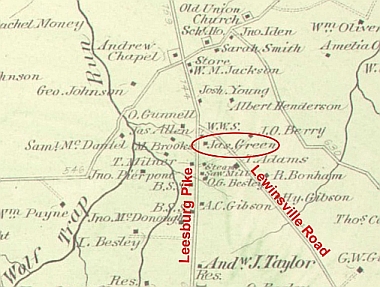
The school at Andrew’s Chapel was held in the upper room of a building owned by a Mr. Green, possibly James W. Green who was a Union man that lived near Andrew’s Chapel. In 1863 he was taken by a squad of Mosby’s men, but he escaped when he was two miles away by taking advantage of his knowledge of the roads.[51] Green received rent for the school, which was paid by subscription. [52] The teacher, Catherine E. Hall, boarded in Green’s home adjacent to a building in the yard that was used for school purposes.[53] Location of the land of James Green near Andrew's Chapel, G. M. Hopkins Map of 1878. Langley On November 28, 1866, O. E. Hine, who assumed the duties of Capt. Ross, recommended that the building belonging to the government located on Mrs. Ball’s farm be given to the African Americans living at Langley for use as a school house. Mrs. Ball’s farm was located on the Washington and Leesburg Turnpike. The building had been reserved from auction since the officer in charge was interested in establishing a freedmen’s camp on Mrs. Ball’s property. The building was originally promised to people in Vienna for a school house once they purchased a lot; however, Hine recommended that the building be given to the freedmen of Langley for a school since it would only have to be moved a distance of one mile. [54] The Langley residents were to have completed the purchase of a lot by mid-December 1866.[55] O. E. Hine wrote to Robert Gunnell and J. Mason, trustees of the colored school Langley Va, authorizing them to remove the board house recently occupied by freedmen on Mrs. Ball’s property for the purpose of constructing a school house. They had until January 15, 1867 to remove the building.[56] In February 1867, Hine reported that the school was under construction.[57] Delay in construction of the school house was caused by the weather, but it was expected to be completed sometime after March 6, 1867 once the weather improved.[58] In November 1868, O. S. B. Wall reported that there was a “rather indifferent colored school under the auspices of some Methodist Society at Langley.” [59] Perhaps the school house was the same building later known as Gunnell’s Chapel which was built on the land of Robert Gunnell and sold to the trustees of the Methodist Church at Langley in 1879.[60] Gunnell, who was one of the school trustees and one of the church trustees, was a free black before the war.[61] Annandale (Mount
Pleasant) A school house measuring 16x24 was constructed at Mount Pleasant near Annandale by April 1867, though there wasn’t a teacher available.[62] The frame building was constructed by Mack Phearson at the request of the Freedmen’s Bureau who furnished some lumber. About $28 was raised by the freedmen through church collection; however, it was agreed that the debt would be paid if the house was taken as a church. Samuel Strother agreed to work on erecting the building with the belief that since it would be a church, he would be paid.[63] On September 7, 1867, Charles H. Brown and Eliza C. Brown, his wife, donated the one acre lot with the existing buildings to four freedmen who acted as trustees: Andrew Jackson, Fenton Somers, William Nest, and John Curry. A stipulation in the deed required that the lot be used exclusively for religious and school purposes and a burying ground by those who reside on the land Charles Brown subdivided into lots and sold to freedmen.[64] It is unknown if this school ever officially operated during the Reconstruction Period since there weren’t any school reports provided to the Freedmen’s Bureau for Annandale/Mount Pleasant. | ||||||||||||||||||||||||||||
| BUILDING AND REPAIRING SCHOOLS | ||||||||||||||||||||||||||||
|
In addition to providing materials for constructing new school houses, the Freedmen’s Bureau also provided funds and materials for the repair of school houses. Often the school houses were constructed using surplus lumber no longer needed by the army, though requests for window sash, hinges, and nails were also made.[65] Typically the freedmen constructed the school buildings themselves or hired carpenters. In April 1867 there were eight school buildings in Fairfax County for African Americans and two schools held in rented spaces. The Langley school house was not yet completed. The school houses ranged in size from 360 sf to 540 sf. The largest school houses, located at Fairfax Courthouse, Falls Church, and Woodlawn (Accotink) measured 30x18. At this time the schools were filled to capacity, and the school at Fairfax Courthouse was severely overcrowded.[66] 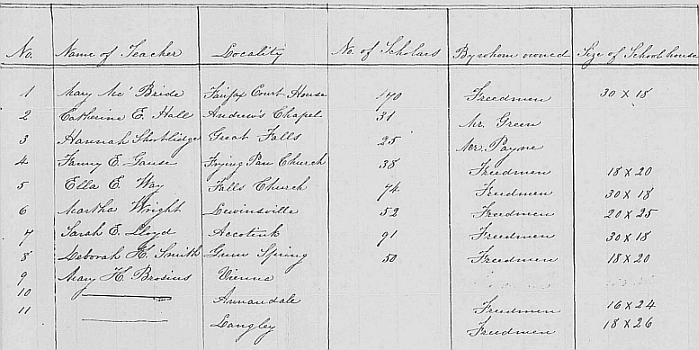
Report of Schools,
School houses, &c. of Fairfax County, Virginia, Freedmen’s Bureau Records
of Field Offices By October 1868 there were nine school buildings in Fairfax County for African Americans. Four of the buildings were frame construction and five were constructed of logs.[67] 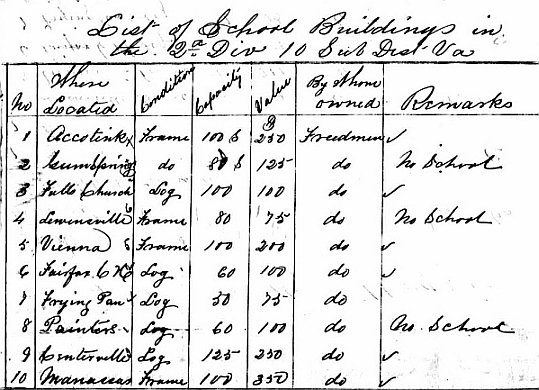
List of School
Buildings, October 1868, Freedmen’s Bureau Records of Field Offices | ||||||||||||||||||||||||||||
| BUILDINGS USED FOR BOTH SCHOOL AND CHURCH PURPOSES | ||||||||||||||||||||||||||||
|
A number of
the school houses were used for both school and church purposes. Gum Springs 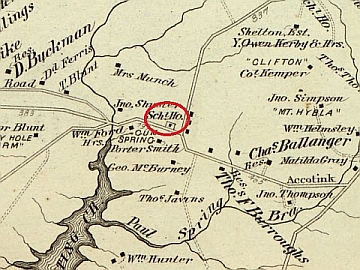
A building was constructed at Gum Springs for both school and church purposes, likely sometime in the fourth quarter of 1866.[68] The school opened on February 1, 1867 with Deborah K. Smith as the teacher. Ms. Smith was assigned to Gum Springs by the Friends Association of Philadelphia.[69] In support of the school and community, the Association sent Smith a barrel containing books, seeds, shoes, and clothing.[70] The school was administered by trustees of the school, one of whom was Lovelace Brown, a prominent man in the community.[74] Location of Gum
Springs School, Atlas of Fifteen Miles Around Washington Including the County
of Prince George Maryland, by G. M. Hopkins, 1878. The 18x20 log building was constructed on the land of John A. Seaton, a man of means who had been a free black living in Alexandria.[71] His parents were freed from slavery by George Washington.[72] Both he and his brother George Seaton were carpenters. George Seaton built the Alexandria School for the Freedmen’s Bureau in 1867.[73] John A. Seaton, New
York Herald, July 2, 1893 Lincoln Village (Later
known as Lincolnville, Present-day Chesterbrook) In March 1866, four freedmen living at Camp Rucker, a former contraband camp located on the farm of Mr. Nutt near Falls Church, had a missionary write to the Freedmen’s Bureau on their behalf. They were told they must leave the farm by April 1st since the land was returned to the owner. They inquired whether they could remain on the farm under lease agreements, or if not, where they might be able to lease land. They also wanted to know if they could take their houses with them if they were required to leave.[75]The government had constructed 16 log houses, one frame house, and a barn on Mr. Nutt’s farm.[76] The freedmen were permitted to take the log houses but not the frame house and barn.[77] Mr. Downey, who leased the farm from Mr. Nutt, wrote to the Freedmen’s Bureau on April 4, 1866 that the freedmen had taken down some of the cabins since they had permission from other landowners to build upon their lands. Downey expected he would have only five cabins left; however, other freedmen were trying to obtain lots of land and if they could get them he expected that they would remove more of the cabins. Downey requested assistance from the Bureau to provide a team to haul the buildings for the freedmen since they did not have a means of moving the buildings themselves, though the next day he learned that the freedmen had obtained teams to haul away the cabins.[78] The four freedmen (Hiram Kinner, Robert Parker, Phelan Robinson, and Milton Edmonds) who had asked where they might be able to lease land settled on lots sold to them by James H. Crocker.[79] The area became known as Lincoln Village. By 1868, about 20 African American families lived in Lincoln Village, located about three miles southeast of Lewinsville. They typically bought lots of land for homesteads varying in size from about one to five acres each. James Crocker and his brother, Union Gen. John S. Crocker (both formerly from New York) subdivided farms and sold lots to former slaves. [80] The freedmen had five years from the date of purchase to pay for the land. [81] It appears that deeds were recorded at the Fairfax County Courthouse once the purchase price was paid. O.S.B. Wall visited the area on an inspection tour for the Freedmen’s Bureau in November 1868 and expressed doubt that the freedmen would be able to meet their payments because the land was exhausted and in an unproductive condition.[82] While some of the original lot owners did not receive deeds, many did and the area became an established community.[83] By July 1866, Capt. John A. Ross had raised $203.50 from the freedmen near Lewinsville for the purpose of purchasing land for a church and school building.[84] In December 1866 the building construction was complete except for the gallery.[85] On December 26, 1866, Bureau officer Orin Hine requested 300ft boards, 200 brick, and 10 lengths of stove pipe for the school house presumably for construction of a chimney and flue for heating the building.[86] The school that operated in the church/school building was known as the “Friends’ School Near Lewinsville.”[87] The teachers were supplied by the Friends’ Association. [88] The first teacher at Lincoln Village was Martha Wright followed by Sarah M. Ely. Mr. O.S.B. Wall, unaware that the church was originally built for both school and church purposes, observed in November 1868 that Lincoln Village didn’t have a school building, but used “a very good little church which is always cheerfully furnished for school purposes.” [89] The trustees received a deed for the church lot from James H. Crocker and his wife Charlotte on December 1, 1868, though the building was already on the lot.[90] Painter’s School On June 28, 1867, Joseph H. Painter wrote that the freedmen erected a log school house upon grounds given to them for the purpose and now desire lumber, etc. to complete the building. There were over fifty students who had been in attendance at the school taught every Sunday by Mrs. J. H. Painter, proving that a house was necessary. It was estimated that to finish the school house construction they would need 800 feet of one inch boards, six windows, one door, lumber for benches and seats, and shingles for roofing.[91] The Freedmen’s Bureau appropriated $75 to make the necessary repairs to the school house. On November 28, 1868, O.S.B. Wall visited Painter’s School. In the community were about 30 families of freedmen with 34 children between the ages of 4 and 16 years. The school house was constructed of hewn logs measuring 22 feet by 18 feet. It was built by the freedmen entirely except for the appropriation by the Bureau of $75. The lot on which the school stood belonged to Mr. Painter, a white man described as a good friend to the freedmen. The building was at the time used for church purposes and there was never a day or night school there except on Sunday, which was taught by Mrs. Painter who, with her husband, moved to Richmond about three months prior. The freedmen desired a teacher, though they couldn’t afford to pay a salary.[92] Woodlawn (aka
Accotink) The school at Woodlawn was opened on June 15, 1866 by teacher Sarah E. Lloyd. She initially had 13 students which increased rapidly to 40 students. Where she held class is unknown; however, she noted that her class could have been larger had the room where the school was held been bigger. During the summer break, it was anticipated that the area African Americans would construct a house for church and school purposes.[93] In August 1866 George and Warrington Gillingham, Quakers from New Jersey who owned part of the Woodlawn estate, sold one acre of land to the Woodlawn Colored Meeting and School Association for forty dollars. The trustees of the Association were William Holland, John Green, William Franklin Moore, James Dent, and Stephen Blair.[94] The lot was located at the present-day location of the Woodlawn Methodist Cemetery.[95] The number of pupils who attended the school continued to increase. By April 1867 there were 91 scholars, the second highest enrollment of African Americans in Fairfax County. The school building was of frame construction and measured 30x18.[96] Vienna Although the location of the first school at Vienna, which opened in March 1866, is unknown, repairs to the school house were underway later that year. [97] On September 18, 1866, Capt. J. A. Ross wrote to S. P. Lee to learn the disposition of supplies he requested for repairing school houses. Ross noted that a school teacher was there in Vienna waiting for her school to be completed.[98] The teacher, Mary K. Brosius, wrote that the school house was so small that she almost had to stack the pupils since she didn’t have the heart to turn anyone away. She hoped to have a larger school house in March or April of 1867.[99] The second school house was built on land owned by Major O. E. Hine, who was once the Freedmen’s Bureau’s Assistant Superintendent for Fairfax County. He conveyed 1/8 acre of land to Daniel West, George M. Brown, and Edmond Harris, trustees of the colored school at Vienna on September 1, 1867. The land would belong to the trustees so long as the lot was used for school or church purposes.[100] The second school house was constructed on a lot of land on Lawyers Road near Church Street. 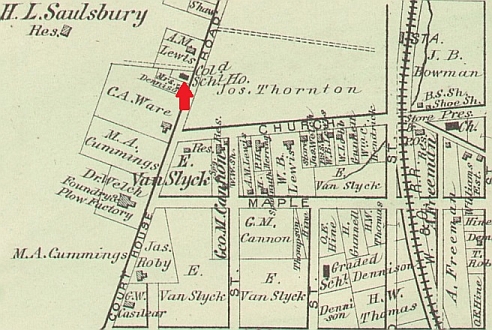
Location of Vienna
Colored School, Atlas of Fifteen Miles Around Washington Including the County
of Prince George Maryland, by G. M. Hopkins, 1878. O. E. Hine wrote to the Bureau to obtain materials for building the school house. He had been attempting to acquire lumber since February 1867. The freedmen had already raised the money to purchase the lot and to pay carpenters to do the construction.[101] 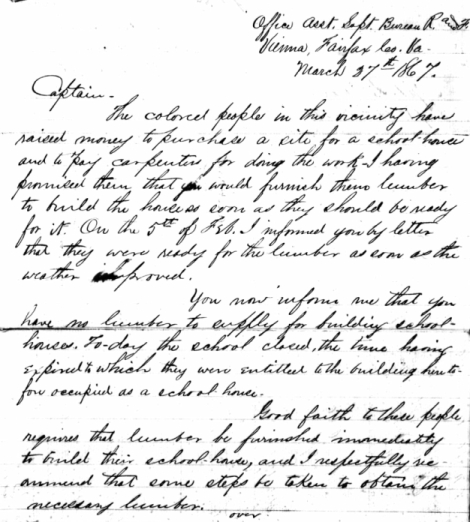
Letter from O.E. Hine
requesting lumber for a school house at Vienna. Freedmen's Bureau Field Office Records Once built, the school house measured 20’x30’ and was constructed out of hewn logs with a board roof. The building belonged to the freedmen. On November 24, 1868, O.S.B. Wall reported that Catherine Hall was the teacher at Vienna. She was employed by the Friends Society of Philadelphia at a salary of $35 per month. The school was in grade Primary with one or two advanced classes. Miss Hall also taught a night school. | ||||||||||||||||||||||||||||
| OTHER SCHOOLS | ||||||||||||||||||||||||||||
|
Big Falls (Great
Falls) The school at Great Falls was owned by Mr. Payne. Rents were paid by subscription. The teacher in April 1867 was Hannah Shortbridge.[102] Centreville School —
Rock Hill African Americans in the Centreville area commenced building a school house and requested funds for its completion. On February 13, 1868, Charles Harris requested $150 from the Freedmen’s Bureau for school construction.[103] 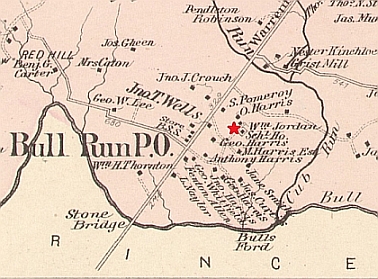
Location of
Centreville Freedmen’s School, G. M. Hopkins Map, 1878 The school house, known as Rock Hill School, was built on land donated by Jesse Harris near Bull Run.[104] It opened on February 17, 1868. The teacher, Benjamin F. Grant, noted in his school report that the school was in a great need of books.[105] The Friends Association of Philadelphia offered to pay 10 or 15 dollars per month to the teacher. Grant was an African American born in Pennsylvania.[106] Grant had a day school with average attendance of 18 students, 12 of whom were free before the war.[107] The night school had 15 young men as scholars. 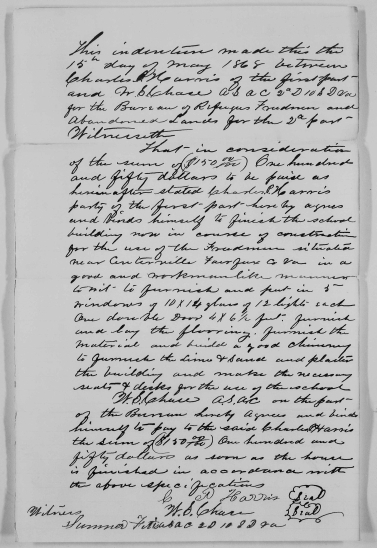
Construction Contract
to Build Centreville Freedmen’s School, Image Courtesy FamilySearch.org The Freedmen’s Bureau entered into a contract with Charles P. Harris, a free Black before the war, to complete construction of the school house. The contract described the specifications for construction of the building. The school house was required to have five windows with 10x14 glass of twelve lights each and a double door measuring 4 x 6 1/2 feet. Harris was to lay the flooring, build a chimney, plaster the building, and make the necessary desks and seats for the use of the school.[108] On June 3, 1868, S. P. Lee forwarded a check for $150 to C. P. Harris and directed that the funds not be paid out until the building is complete.[109] A notation in a report stated that four carpenters were employed to work on the school house for 15 days at $2.50 per day.[110] Falls Church There were at least two schools at Falls Church for the education of freedmen during Reconstruction. One was the Mission School operated by Baptists. The other school, which was connected with the Friends’ Association, was started by Mrs. A. Ekins Rutdge and her daughter in January 1866.[111] Emily Howland, known for her work educating freedmen, was the school superintendent from April 7, 1866 to July 24, 1866.[112] The Rutdges received $40 per month from the Friends’ Association, though they were replaced by a new teacher, Eliza (Ella) E. Way, in June 1866.[113] George Rubble, an African American, was one of the trustees of the school.[114] In June 1867 Eliza Way wrote to the Friends Association: | ||||||||||||||||||||||||||||
|
I am very anxious to teach every day this month, having missed one or more days in each previous month; but the rain has already prevented this, and many of the children are detained at home in consequence of farm work, which makes the school small. With the assistance of some of those friendly disposed toward us here, we have organized a First Day School, and we are getting along nicely. There are now two in the village, numbering, I should think, about two hundred scholars, and they all seem to take great interest in them. Some came to-day quite a distance in the rain. The other school is conducted by the Baptists’, and they think we will not prosper; but we are determined we will, and will work hard for it.[115] | ||||||||||||||||||||||||||||
|
The site in Falls Church where this school was located is unknown; however, Freedmen’s Bureau documents do reveal that the school house measured 30x18 and was constructed of logs.[116] The school teacher continued to change each year. In September 1867, Philena Heald was the teacher.[117] And in October 1868 Harriet Jenkins taught at the school. Jenkins was one of two African-American teachers in Fairfax County who reported school statistics to the Freedmen’s Bureau. Jenkins’ school was known as Mt. Pisgah, likely in biblical reference to the mountain where Moses looked out onto the Promised Land that was pledged to freed slaves.[118] Springfield and
Burkes Station On March 30, 1868, Lieut. W. S. Chase wrote that he intended to visit a number of schools including Springfield and Burkes Station.[119] This is the only mention of these two schools found to date in the Freedmen’s Bureau records. It is unknown if he was only visiting Freedmen schools. | ||||||||||||||||||||||||||||
| FUNDING DECLINES | ||||||||||||||||||||||||||||
|
After a few years, it became more difficult to obtain funding to pay teacher salaries from the Friends’ Association of Philadelphia. To compensate for the reduced donations, the freedmen at Vienna formed a school association to raise funds for the teacher’s salary.[120] At Lincoln Village, O.S.B. Wall hoped that the Friends’ Association would continue their support. [121] He formed a Parents School Association to collect contributions to help fund the teacher’s salary for the winter of 1869. [122] In January 1869, O.S.B. Wall forwarded a letter to S. P. Lee from Mr. Robert Roberson suggesting that something be done for the school at Lincoln Village. They employed a new teacher, E. A. Henry, at a small salary of $10 per month and they provided board for her. Lee thought the Bureau would be able to pay 25 cents per pupil, though the difference amounting to 3 or 4 dollars would need to be made up by soliciting contributions themselves.[123] General Crocker and O.S.B. Wall agreed to make up the difference in what was owed the teacher.[124] The following month, the teacher followed up by requesting aid from the Freedmen’s Bureau to support the school.[125] Lee later learned that funds from the Bureau were no longer available.[126] Additional funding sources were also needed at the end of 1868 for the Rock Hill School near Centreville. The teacher wrote to the Freedmen’s Bureau asking if the Freedmen’s Friends Association could be solicited to donate a small sum monthly to help him along.[127] His November school report noted that the school obtained some assistance from the Friends Association of Philadelphia and $8.00 per month was paid by the parents.[128] Support was also obtained from another benevolent society. On March 1, 1869, Oscar M. Waring wrote that the Home Mission Society would provide teachers for Fairfax Court House and Painter’s. The teachers were graduates of Female Seminaries.[129] By February 1869, three of the schools were partially supported by freedmen.[130] | ||||||||||||||||||||||||||||
| TRANSITION TO VIRGINIA EDUCATION SYSTEM | ||||||||||||||||||||||||||||
|
On March 31, 1869 the War Department closed the Educational Sub-Districts that operated in Fairfax County.[131] African American schools became the responsibility of the school districts in 1870 as a result of Virginia’s constitutional requirement for free public education.[132] In reality, however, there was insufficient funding allocated to schools for African Americans. The Friends’ Association continued to support some schools in Fairfax County for a short time, but monetary donations from contributors were waning. In December 1871, Jennie Spear, the teacher at Fairfax Court House wrote the following to the Friends’ Association: | ||||||||||||||||||||||||||||
|
Once again I come with our appeal for the colored people, feeling assured that you still feel an interest in their welfare. I suppose you are aware there is a system of free schools established in Virginia, but generally the salaries are too small to induce a good teacher to risk her health and pay expenses. The trustees are not generally anxious to keep up the colored schools, as the funds are otherwise appropriated. Last winter the school here was kept but two months and then dropped …”[133] | ||||||||||||||||||||||||||||
|
With the end of the Freedmen’s Bureau’s oversight, reports of school statistics were submitted to the Virginia Superintendent of Public Instruction. In February 1869, there were seven schools in Fairfax County that reported statistics to the Freedmen’s Bureau.[134] In 1871, the first year statistics were published by the Virginia Board of Education, there were 13 schools for African American scholars in Fairfax County.[135] | ||||||||||||||||||||||||||||
| ENDNOTES | ||||||||||||||||||||||||||||
|
[1] Freedmen’s Bureau, Summary of Census Returns of Colored People, Fairfax County, Virginia, November 15, 1865, as viewed on February 10, 2014 at http://freedmensbureau.com/washingtondc/fairfaxcensus.htm. [2] Virginia Revised Code, 1819. Revised Code of the Laws of Virginia, 1833, chapter 186. [3] Freedmen’s Bureau Bill, approved March 3, 1865, (13 Stat. 507) The American Nation: Primary Sources, ed. Bruce Frohnen (Indianapolis: Liberty Fund, 2008 as viewed on February 21, 2014 at http://oll.libertyfund.org/?option=com_staticxt&staticfile=show.php%3Ftitle=2282&chapter=216250&layout=html&Itemid=27 [4] School Reports of the 10th Sub District of Virginia, various dates, Freedmen Bureau Field Office Records 1863-1878, as viewed on Ancestry.com, Washington DC>School Reports>. [5] Teacher’s Monthly School Report, Fairfax Courthouse, February 1868, Freedmen Bureau Field Office Records 1863-1878, as viewed on Ancestry.com, Washington DC>School Reports>1867>image 138. [6] Friends’ Intelligencer, Vol. XXI., No. 32, Philadelphia, October 15, 1864, p. 507, as viewed on Google Books. [7] Friends’ Intelligencer, Vol. XXI., No. 41, Philadelphia, December 17, 1864, pp. 650-651, as viewed on Google Books. Note: For the location of the camps, see http://dclawyeronthecivilwar.blogspot.com/search/label/Camp%20Wadsworth [8] Friends’ Intelligencer, Vol. XXI., No. 41, Philadelphia, December 17, 1864, pp. 650-651, as viewed on Google Books.. [9] Friends’ Intelligencer, Vol XXIII., No. 8, Philadelphia, April 28, 1866, pp. 123-124, as viewed on Google Books; Also, Friends’ Intelligencer, Vol XXIII., No. 8, Philadelphia, April 28, 1866, pp. 123-124, as viewed on Google Books. [10] Letter from G [George] B Carse, Ad?? V.R.C. [Veteran Reserve Corp] & Supt. Freedmen to Col John Eaton, Jr. Asst. Commissioner of R. F. & A. L. 23 Jun 1865 Freedmen Bureau Field Office Records 1863-1878, as viewed on Ancestry.com, Washington DC>Other>1865-1868>other documents>image 205. [11] Letter from G [George] B Carse, Ad?? V.R.C. [Veteran Reserve Corp] & Supt. Freedmen to Col John Eaton, Jr. Asst. Commissioner of R. F. & A. L. 23 Jun 1865 Freedmen Bureau Field Office Records 1863-1878, as viewed on Ancestry.com, Washington DC>Other>1865-1868>other documents>image 205. [12] Josephine Pacheco, “A Civil War Freedmen’s School at Falls Church,” Northern Virginia Heritage: A Journal of Local History, Vol III No. 2, June 1981, pp. 9-10. Letters from J. D. Read and Betsy Read to Emily Howland, transcribed in article, describe the difficulties in obtaining assistance from northern charities and the government for school support. [13] Bradley E. Gernand, A Virginia Village Goes to War, The Village Preservation and Improvement Society of Falls Church, Virginia, 2002, pp. 205-208. Transcripts of claims are provided that describe Read’s capture and murder. [14] Letter from D. W. Anderson to Col. S. P. Lee, "Virginia, Freedmen's Bureau Field Office Records, 1865-1872," index and images, FamilySearch (https://familysearch.org/pal:/MM9.3.1/TH-267-11841-79766-79?cc=1596147 : accessed 27 Oct 2014), Alexandria (superintendent) > Roll 46, Registered letters received, vol 2-3, Jan 1867-Dec 1868 > image 335 of 781; citing NARA microfilm publication M1913. [15] Letter from Sidney B. Smith to James J. Ferree, October 1, 1865, "Virginia, Freedmen's Bureau Letters or Correspondence, 1865-1872," index and images, FamilySearch (https://familysearch.org/pal:/MM9.3.1/TH-267-11600-119097-21?cc=1596147 : accessed 06 Apr 2014), 004151197 > image 913 of 1105; citing NARA microfilm publication M1913; Also Letter from Sidney B. Smith to Chaplain John Kimball, October 10, 1865, "Virginia, Freedmen's Bureau Letters or Correspondence, 1865-1872," index and images, FamilySearch (https://familysearch.org/pal:/MM9.3.1/TH-267-11600-113844-54?cc=1596147 : accessed 05 Apr 2014), 004151197 > image 919 of 1105; citing NARA microfilm publication M1913. [16] Letter from George A. Armes to John F. Marsh, August 10, 1865, "Virginia, Freedmen's Bureau Letters or Correspondence, 1865-1872," index and images, FamilySearch (https://familysearch.org/pal:/MM9.3.1/TH-267-11600-119176-19?cc=1596147 : accessed 06 Apr 2014), 004151197 > image 875 of 1105; citing NARA microfilm publication M1913. [17] Beth Mitchell and Edith Moore Sprouse, FAIRFAX COUNTY IN 1860: Property Owners and a Collective Biography, Fairfax County, 1977. [18] Letter from George Armes to General O. O. Howard, September 13, 1865, "Virginia, Freedmen's Bureau Letters or Correspondence, 1865-1872," index and images, FamilySearch (https://familysearch.org/pal:/MM9.3.1/TH-267-11600-114085-97?cc=1596147 : accessed 06 Apr 2014), 004151197 > image 902 of 1105; citing NARA microfilm publication M1913. [19] Letter from Sidney B. Smith to James J. Ferree, September 25, 1865, "Virginia, Freedmen's Bureau Letters or Correspondence, 1865-1872," index and images, FamilySearch (https://familysearch.org/pal:/MM9.3.1/TH-267-11600-119202-6?cc=1596147 : accessed 06 Apr 2014), 004151197 > image 910 of 1105; citing NARA microfilm publication M1913. [20] Letter from Sidney B. Smith to James J. Ferree, October 1, 1865, "Virginia, Freedmen's Bureau Letters or Correspondence, 1865-1872," index and images, FamilySearch (https://familysearch.org/pal:/MM9.3.1/TH-267-11600-119097-21?cc=1596147 : accessed 06 Apr 2014), 004151197 > image 913 of 1105; citing NARA microfilm publication M1913; Also Letter from Sidney B. Smith to Chaplain John Kimball, October 10, 1865, "Virginia, Freedmen's Bureau Letters or Correspondence, 1865-1872," index and images, FamilySearch (https://familysearch.org/pal:/MM9.3.1/TH-267-11600-113844-54?cc=1596147 : accessed 05 Apr 2014), 004151197 > image 919 of 1105; citing NARA microfilm publication M1913. [21] Letter from Sidney B. Smith to Chaplain John Kimball, October 10, 1865, "Virginia, Freedmen's Bureau Letters or Correspondence, 1865-1872," index and images, FamilySearch (https://familysearch.org/pal:/MM9.3.1/TH-267-11600-113844-54?cc=1596147 : accessed 05 Apr 2014), 004151197 > image 919 of 1105; citing NARA microfilm publication M1913. [22] Letter from Sidney B. Smith to James J. Ferree, October 3, 1865, "Virginia, Freedmen's Bureau Letters or Correspondence, 1865-1872," index and images, FamilySearch (https://familysearch.org/pal:/MM9.3.1/TH-267-11600-118690-26?cc=1596147 : accessed 06 Apr 2014), 004151197 > image 915 of 1105; citing NARA microfilm publication M1913. [23] Plat of the Town of Providence and the bounds adjoining previously owned by Richard Ratcliffe, Fairfax County Chancery Case 1847-023, Ratcliffe v.Willcoxen, 1843, Courtesy Fairfax County Circuit Court Archives. [24] “To Friends and Others Interested in the Cause of the Freedmen,” Friends’ Association of Philadelphia for the Aid and Elevation of the Freedmen, Broadside, ca. 1865, Swarthmore College, Quaker Broadsides Collection, as viewed on 2/21/2014 at http://triptych.haverford.edu/cdm/compoundobject/collection/SC_Broad/id/1834/rec/1 [25] Friends’ Intelligencer, Vol. XXIII., No. 39, Philadelphia, December 1, 1866, p. 617, as viewed on Google Books. [26] The Nation, Vol I, No. 19, November 9, 1865,in The Nation: A Weekly Journal Devoted to Politics, Literature, Science, and Art, Joseph H. Richards, Publisher, NY, 1865, p. 580, as viewed on Google Books; Friends’ Intelligencer, Vol XXII., No. 39, Philadelphia, December 2, 1865, p. 622. [27] Friends’ Intelligencer, Vol XXIII., No. 7, Philadelphia, April 21, 1866, pp. 109-111, as viewed on Google Books. [28] Friends’ Intelligencer, Vol XXIII., No. 7, Philadelphia, April 21, 1866, pp. 109-111, as viewed on Google Books. [29] Friends’ Intelligencer, Vol XXIII., No. 7, Philadelphia, April 21, 1866, pp. 109-111, as viewed on Google Books. [30] Friends’ Intelligencer, Vol XXIII., No. 7, Philadelphia, April 21, 1866, pp. 109-111, as viewed on Google Books. [31] Friends’ Intelligencer, Vol XXIII., No. 7, Philadelphia, April 21, 1866, pp. 109-111, as viewed on Google Books. [32] Friends’ Intelligencer, Vol XXIII., No. 8, Philadelphia, April 28, 1866, pp. 123-124, as viewed on Google Books. [33] Letter from James A Ross to S. P. Lee, November 4, 1866, Freedmen Bureau Field Office Records 1863-1878, as viewed on Ancestry.com, Virginia>Letter>1866>image 9300. [34] Report of O.S.B. Wall to Col S. P. Lee, November 23, 1868, Freedmen Bureau Field Office Records 1863-1878, as viewed on Ancestry.com, Virginia>Letter>1866>image 1535-1537. [35] Friends’ Intelligencer, Vol XXIII., No. 10, Philadelphia, May 12, 1866, p. 154, as viewed on Google Books. [36] Letter forwarded to Gen Howard Freedmen’s Bureau of Virginia, 06 May 1866, Endorsements Sent and Received, November 1865 – Mar 1867, Roll 42, image 30 of 67, citing NARA microfilm publication M1913, as viewed on familysearch.org. [37] Friends’ Intelligencer, Vol XXIII., No. 16, Philadelphia, June 23, 1866, pp. 249-251, as viewed on Google Books. [38] Report of O. E. Hines, December 1, 1866, Freedmen Bureau Field Office Records 1863-1878, as viewed on Ancestry.com, Virginia>Letter>1866>image 9367. [39] Report of O. E. Hines, December 1, 1866, Freedmen Bureau Field Office Records 1863-1878, as viewed on Ancestry.com, Virginia>Letter>1866>image 9367. [40] Letter from J A Ross to BVT Col S. P. Lee, June 30 1866, "Virginia, Freedmen's Bureau Field Office Records, 1865-1872," index and images, FamilySearch (https://familysearch.org/pal:/MM9.3.1/TH-267-11045-45679-34?cc=1596147 : accessed 11 Nov 2014), Alexandria (superintendent) > Roll 48, Unregistered letters received, May 1866-Apr 1869 > image 182 of 330; citing NARA microfilm publication M1913, National Archives and Records Administration, College Park, Maryland. [41] Letter from O. E. Hine to Capt. S. P. Lee, December 1, 1866, Freedmen Bureau Field Office Records 1863-1878, as viewed on Ancestry.com, Virginia>Letter>1866>image 9364. [42] Letter from O. E. Hine to Capt. S. P. Lee, January 1, 1867, Freedmen Bureau Field Office Records 1863-1878, as viewed on Ancestry.com, Virginia>Letter>1867>image 12226-12230. [43] 25 May 1867 Friends’ Intelligencer, Vol XXIV., No. 12, May 25, 1867, p. 187, as viewed on Google Books. [44] Letter from Fanny E. Gouse, Teacher, February 14, 1867 and from J. R. Johnson, February 18, 1867, "Virginia, Freedmen's Bureau Letters or Correspondence, 1865-1872," index and images, FamilySearch (https://familysearch.org/pal:/MM9.3.1/TH-267-11600-111456-10?cc=1596147&wc=MJW7-2NL:1042225801 : accessed 14 Apr 2014), 004151197 > image 1055 of 1105; citing NARA microfilm publication M1913. [45] Friends’ Intelligencer, Vol XXIII., No. 8, Philadelphia, April 28, 1866, pp. 123-124, as viewed on Google Books; Also, Friends’ Intelligencer, Vol XXIII., No. 8, Philadelphia, April 28, 1866, pp. 123-124, as viewed on Google Books. [46] Friends’ Intelligencer, Vol XXIII., No. 7, Philadelphia, April 21, 1866, pp. 109-111, as viewed on Google Books; Also, Friends’ Intelligencer, Vol XXIII., No. 16, Philadelphia, June 23, 1866, pp. 249-251, as viewed on Google Books. [47] Report of O. E. Hines, December 1, 1866, Freedmen Bureau Field Office Records 1863-1878, as viewed on Ancestry.com, Virginia>Letter>1866>image 9367. [48] Report of O.S.B. Wall to Col S. P. Lee, November 27, 1868, Freedmen Bureau Field Office Records 1863-1878, as viewed on Ancestry.com, Virginia>Letter>1869>image 1550-1552. [49] Fairfax County Deed Book X3:14. [50] Report of O.S.B. Wall to Col S. P. Lee, December 12, 1868, Freedmen Bureau Field Office Records 1863-1878, as viewed on Ancestry.com, Virginia>Letter>1869>image 1557-1558. [51] James W. Green, Southern Claims Commission, Roll 13, Target 11, Fairfax County, VA, as viewed on Ancestry.com. [52] Report of Schools, School houses, &c. of Fairfax County, Virginia, "Virginia, Freedmen's Bureau Letters or Correspondence, 1865-1872," index and images, FamilySearch (https://familysearch.org/pal:/MM9.3.1/TH-267-11093-141699-91?cc=1596147 : accessed 14 Apr 2014), 004150376 > image 947 of 1204; citing NARA microfilm publication M1913. [53] Friends’ Intelligencer, Vol XXIV., No. 12, May 25, 1867, p. 187, as viewed on Google Books. [54] Letter from O. E. Hine to Capt. S. P. Lee, November 28, 1866, Freedmen Bureau Field Office Records 1863-1878, as viewed on Ancestry.com, Virginia>Letter>1866>image 9349. [55] Letter from O. E. Hine to Capt. S. P. Lee, November 28, 1866, Freedmen Bureau Field Office Records 1863-1878, as viewed on Ancestry.com, Virginia>Letter>1866>image 9349. [56] Letter from O. E. Hine to Robert Gunnell and J. Mason, "Virginia, Freedmen's Bureau Field Office Records, 1865-1872," index and images, FamilySearch (https://familysearch.org/pal:/MM9.3.1/TH-267-11600-119687-99?cc=1596147 : accessed 06 Nov 2014), Fairfax Courthouse (Fairfax County, assistant subassistant commissioner) > Roll 75, Letters sent, Aug 1865-Oct 1868 > image 77 of 146; citing NARA microfilm publication M1913, National Archives and Records Administration, College Park, Maryland. [57] Letter from O. E. Hine noted in Index, February 6, 1867, Freedmen Bureau Field Office Records 1863-1878, as viewed on Ancestry.com, Virginia>Letter>1866>image 8945. [58] Letter from O. E. Hine, March 6, 1867, "Virginia, Freedmen's Bureau Field Office Records, 1865-1872," index and images, FamilySearch (https://familysearch.org/pal:/MM9.3.1/TH-267-11600-118581-22?cc=1596147 : accessed 07 Nov 2014), Fairfax Courthouse (Fairfax County, assistant subassistant commissioner) > Roll 75, Letters sent, Aug 1865-Oct 1868 > image 91 of 146; citing NARA microfilm publication M1913, National Archives and Records Administration, College Park, Maryland. [59] Report of O.S.B. Wall to Col S. P. Lee, November 27, 1868, Freedmen Bureau Field Office Records 1863-1878, as viewed on Ancestry.com, Virginia>Letter>1866>image 1550-1552. [60] Fairfax County Deed Book A5(105)428, December 17, 1879. [61] Robert Gunnell manumission, Fairfax County Deed Book X3(76)339, November 6, 1851. [62] Report of Schools, School houses, &c. of Fairfax County, Virginia, "Virginia, Freedmen's Bureau Letters or Correspondence, 1865-1872," index and images, FamilySearch (https://familysearch.org/pal:/MM9.3.1/TH-267-11093-141699-91?cc=1596147 : accessed 14 Apr 2014), 004150376 > image 947 of 1204; citing NARA microfilm publication M1913. [63]Depositions in Mount Pleasant Church/School Case, "Virginia, Freedmen's Bureau Field Office Records, 1865-1872," index and images, FamilySearch (https://familysearch.org/pal:/MM9.3.1/TH-267-11841-73243-25?cc=1596147 : accessed 21 Oct 2014), Alexandria (superintendent) > Roll 46, Registered letters received, vol 2-3, Jan 1867-Dec 1868 > image 358 of 781; citing NARA microfilm publication M1913. [64] Fairfax County Deed Book H4(86)282, September 7, 1867. [65] Letter from J. A. Ross, Capt & Asst. Supt. to Col S. P. Lee, Supt Alexandria & Fairfax Cos VA, September 28, 1866, Freedmen Bureau Field Office Records 1863-1878 teachers. Ancestry.com Virginia>Letters>1866>letter documents>image 9181. Also, Letter from William Sheilds to Capt. S. P. Lee, April 26, 1867, "Virginia, Freedmen's Bureau Field Office Records, 1865-1872," index and images, FamilySearch (https://familysearch.org/pal:/MM9.3.1/TH-267-11093-141817-19?cc=1596147 : accessed 15 Nov 2014), Alexandria (superintendent) > Roll 43, Registered letters received, vol 2, 1-407, Mar-Jun 1867 > image 152 of 394; citing NARA microfilm publication M1913, National Archives and Records Administration, College Park, Maryland. [66] Report of Schools, School houses, &c. of Fairfax County, Virginia, "Virginia, Freedmen's Bureau Letters or Correspondence, 1865-1872," index and images, FamilySearch (https://familysearch.org/pal:/MM9.3.1/TH-267-11093-141699-91?cc=1596147 : accessed 14 Apr 2014), 004150376 > image 947 of 1204; citing NARA microfilm publication M1913. [67] List of School Buildings in the 2nd Div 10 Sub District – VA, October 1868, Freedmen Bureau Field Office Records 1863-1878, as viewed on Ancestry.com. [68] Letter from O. E. Hine, Asst. Supt. To Captain S. P. Lee, Supt. Bureau for Alexandria and Fairfax Counties, January 1, 1867, Freedmen Bureau Field Office Records 1863-1878, as viewed on Ancestry.com Virginia>Letters>1867>letter documents>image 12229 [69] Friends Intelligencer, Vol XXIII, February 1867, p. 826, as viewed on Google Books. [70] Friends Intelligencer, Vol. XXIV, published March 1867, article written February 1867, p. 31, as viewed on Google Books. [71] Fairfax County Deed Book G4(85)210, July 9, 1866. [72] “A Colored Giant: A Talk with Alderman Seaton, of Alexandria,” Washington Bee, June 21, 1884, p. 3. [73] Letter from Capt. S. P. Lee to Bvt. Brig. Genl. O. Brown, June 3, 1867, Familysearch.org. [74] Letter from O.S.B. Wall to Col. S. P. Lee, November 17, 1868, "Virginia, Freedmen's Bureau Field Office Records, 1865-1872," index and images, FamilySearch (https://familysearch.org/pal:/MM9.3.1/TH-266-11128-34998-26?cc=1596147 : accessed 26 Oct 2014), Alexandria (superintendent) > Roll 45, Registered letters received, vol 3, 387-1279, Apr-Dec 1868 > image 726 of 843; citing NARA microfilm publication M1913. [75] Letter from Joseph R Johnson to Lt. Clark, March 26, 1866,"Virginia, Freedmen's Bureau Field Office Records, 1865-1872," index and images, FamilySearch (https://familysearch.org/pal:/MM9.3.1/TH-266-11846-27511-9?cc=1596147 : accessed 05 Nov 2014), Alexandria (superintendent) > Roll 47, Unregistered letters received, Mar 1863-Apr 1866 > image 867 of 987; citing NARA microfilm publication M1913, National Archives and Records Administration, College Park, Maryland. [76] Letter from J. A. Ross to Maj. S. P. Lee, March 13, 1866, "Virginia, Freedmen's Bureau Field Office Records, 1865-1872," index and images, FamilySearch (https://familysearch.org/pal:/MM9.3.1/TH-267-11600-116562-45?cc=1596147 : accessed 11 Nov 2014), Fairfax Courthouse (Fairfax County, assistant subassistant commissioner) > Roll 75, Letters sent, Aug 1865-Oct 1868 > image 66 of 146; citing NARA microfilm publication M1913, National Archives and Records Administration, College Park, Maryland. [77] Maj. S. P. Lee to W. W. Rogers, March 20, 1866, "Virginia, Freedmen's Bureau Field Office Records, 1865-1872," index and images, FamilySearch (https://familysearch.org/pal:/MM9.3.1/TH-266-11596-150890-25?cc=1596147 : accessed 11 Nov 2014), Alexandria (superintendent) > Roll 42, Endorsements sent and received, Nov 1865-Mar 1867 > image 20 of 67; citing NARA microfilm publication M1913, National Archives and Records Administration, College Park, Maryland. [78] Letter from J. M. Downey to Major S. P. Lee, April 4, 1866, "Virginia, Freedmen's Bureau Field Office Records, 1865-1872," index and images, FamilySearch (https://familysearch.org/pal:/MM9.3.1/TH-266-11846-29060-85?cc=1596147 : accessed 11 Nov 2014), Alexandria (superintendent) > Roll 47, Unregistered letters received, Mar 1863-Apr 1866 > image 917 of 987; citing NARA microfilm publication M1913, National Archives and Records Administration, College Park, Maryland. [79] Federal Census of 1870, Fairfax County Deed Book Z4(104)247, Fairfax County Deed Book I5(113)165. [80] Boston Journal, September 15, 1890, p. 4, Gen. John S. Crocker obituary. [81] Report of O.S.B. Wall to Col S. P. Lee, November 27, 1868, Freedmen Bureau Field Office Records 1863-1878, as viewed on Ancestry.com, Virginia>Letter>1869>image 1550-1552. [82] Report of O.S.B. Wall to Col S. P. Lee, November 27, 1868, Freedmen Bureau Field Office Records 1863-1878, as viewed on Ancestry.com, Virginia>Letter>1869>image 1550-1552. [83] Fairfax County Deed Books: K4(89)141, J4(88)440, Z4(104)247, K5(115)395, T4(98)25, C5(107)248. [84] Register of Letter from J. A. Ross, July 10, 1866, "Virginia, Freedmen's Bureau Field Office Records, 1865-1872," index and images, FamilySearch (https://familysearch.org/pal:/MM9.3.1/TH-266-11596-149155-48?cc=1596147&wc=9LMK-3TL:1078510502,1078511801 : accessed 22 Oct 2014), Alexandria (superintendent) > Roll 42, Registers of letters received, vol 1-3, Jul 1866-Dec 1868 > image 4 of 602; citing NARA microfilm publication M1913. [85] Friends’ Intelligencer, Vol. XXIII., No. 39, Philadelphia, December 1, 1866, p. 617, as viewed on Google Books. [86] Index of letter from O. E. Hine, December 26, 1866, Freedmen Bureau Field Office Records 1863-1878, as viewed on Ancestry.com, Virginia>Letter>1866>image 8934. [87] School Report cover, Sarah M. Ely, March 1867, "Virginia, Freedmen's Bureau Field Office Records, 1865-1872," index and images, FamilySearch (https://familysearch.org/pal:/MM9.3.1/TH-267-11848-27055-69?cc=1596147 : accessed 16 Nov 2014), Alexandria (superintendent) > Roll 50, School reports, Apr 1867-Mar 1869 > image 3 of 960; citing NARA microfilm publication M1913, National Archives and Records Administration, College Park, Maryland. [88] Request for transportation for Miss Sarah M. Ely from W. S. Chase, "Virginia, Freedmen's Bureau Field Office Records, 1865-1872," index and images, FamilySearch (https://familysearch.org/pal:/MM9.3.1/TH-266-11596-147999-16?cc=1596147&wc=9LMK-3TL:1078510502,1078511801 : accessed 22 Oct 2014), Alexandria (superintendent) > Roll 42, Registers of letters received, Vol. 1-3, Jul 1866-Dec 1868 > image 393 of 602; citing NARA microfilm publication M1913. [89] Report of O.S.B. Wall to Col S. P. Lee, November 27, 1868, Freedmen Bureau Field Office Records 1863-1878, as viewed on Ancestry.com, Virginia>Letter>1869>image 1550-1552. [90] Fairfax County Deed Book J4(88)494, December 1, 1866. [91] Letter from J. H. Painter, Letter Book, June 28, 1867, "Virginia, Freedmen's Bureau Letters or Correspondence, 1865-1872," index and images, FamilySearch (https://familysearch.org/pal:/MM9.3.1/TH-267-11600-118807-23?cc=1596147&wc=MJW7-2NL:1042225801 : accessed 14 Apr 2014), 004151197 > image 1066 of 1105; citing NARA microfilm publication M1913. [92] Report of O.S.B. Wall to Col S. P. Lee, November 28, 1868, Freedmen Bureau Field Office Records 1863-1878, as viewed on Ancestry.com, Virginia>Letter>1869>image 1542-1544. [93] Friends’ Intelligencer, Vol XXIII., No. 30, Philadelphia, September 29, 1866, p. 471, as viewed on Google Books. [94] Fairfax County Deed Book G4(85)338, August 1866. [95] Fairfax County Deed Book G4(85)338, August 1866; see also http://www.woodlawn-umc.org/5.html viewed 10/19/14. [96] Report of Schools, School houses, &c. of Fairfax County, Virginia, Virginia, Freedmen’s Bureau Letters or Correspondence, 1865-1872, Alexandria Roll 43, Registered Letters Received, Volume 2, March-June 1867, image 141. [97] Friends’ Intelligencer, Vol XXIII., No. 8, Philadelphia, April 28, 1866, pp. 123-124, as viewed on Google Books. [98] Letter from J. A. Ross to S. P. Lee, September 18, 1866, Freedmen Bureau Field Office Records 1863-1878, as viewed on Ancestry.com, Virginia>Letter>1866>image 9146. [99] Friends’ Intelligencer, Vol XXIII, 02 Feb 1867, Philadelphia, p. 825, as viewed on Google Books. [100] Fairfax Deed Book E5(109)292, 01 Sep 1867. [101] Letter from O. E. Hine, March 27, 1867, Freedmen Bureau Field Office Records 1863-1878, as viewed on Ancestry.com, Virginia>Letter>1867>image 12534. [102] Report of Schools, School houses, &c. of Fairfax County, Virginia, "Virginia, Freedmen's Bureau Letters or Correspondence, 1865-1872," index and images, FamilySearch (https://familysearch.org/pal:/MM9.3.1/TH-267-11093-141699-91?cc=1596147 : accessed 14 Apr 2014), 004150376 > image 947 of 1204; citing NARA microfilm publication M1913. [103] Letter from Charles Harris, February 13, 1868, "Virginia, Freedmen's Bureau Letters or Correspondence, 1865-1872," index and images, FamilySearch (https://familysearch.org/pal:/MM9.3.1/TH-267-11600-116111-20?cc=1596147&wc=MJW7-2NL:1042225801 : accessed 14 Apr 2014), 004151197 > image 1093 of 1105; citing NARA microfilm publication M1913. [104] Letter from W. S. Chase to Lt. Col. S. P. Lee, March 25, 1868, Fairfax Courthouse Roll 75 Letters sent Aug 1865-Oct 1868, pp. 277-278, Familysearch.org. Also Teacher’s Monthly School Report, Rock Hill School, March 1868, Freedmen Bureau Field Office Records 1863-1878, as viewed on Ancestry.com, VA>School Reports>1868>image 225-226. [105] Teacher’s Monthly School Report, Rock Hill School, March 1868, Freedmen Bureau Field Office Records 1863-1878, as viewed on Ancestry.com, VA>School Reports>1868>image 225-226. [106] Letter from John M. Ellis to Lieut. W. S. Chase, June 23, 1868, "Virginia, Freedmen's Bureau Field Office Records, 1865-1872," index and images, FamilySearch (https://familysearch.org/pal:/MM9.3.1/TH-267-12393-181219-80?cc=1596147 : accessed 26 Oct 2014), Fairfax Courthouse (Fairfax County, assistant subassistant commissioner) > Roll 76, Letters and orders received, Jul 1865-Nov 1868 > image 696 of 755; citing NARA microfilm publication M1913; Also 1870 United States Federal Census. [107] Rock Hill School Report, November 1868, "Virginia, Freedmen's Bureau Field Office Records, 1865-1872," index and images, FamilySearch (https://familysearch.org/pal:/MM9.3.1/TH-267-11848-23601-91?cc=1596147 : accessed 17 Nov 2014), Alexandria (superintendent) > Roll 50, School reports, Apr 1867-Mar 1869 > image 471 of 960; citing NARA microfilm publication M1913, National Archives and Records Administration, College Park, Maryland. [108] Construction contract for Centreville School between Charles P. Harris and W. S. Chase, May 15, 1868, "Virginia, Freedmen's Bureau Field Office Records, 1865-1872," index and images, FamilySearch (https://familysearch.org/pal:/MM9.3.1/TH-266-11074-95911-24?cc=1596147 : accessed 26 Oct 2014), Alexandria (superintendent) > Roll 55, Misc records, 1865-1868 > image 825 of 1028; citing NARA microfilm publication M1913. [109] Letter from S. P. Lee to W. S. Chase, June 3, 1868, "Virginia, Freedmen's Bureau Field Office Records, 1865-1872," index and images, FamilySearch (https://familysearch.org/pal:/MM9.3.1/TH-267-12393-180395-75?cc=1596147 : accessed 26 Oct 2014), Fairfax Courthouse (Fairfax County, assistant subassistant commissioner) > Roll 76, Letters and orders received, Jul 1865-Nov 1868 > image 662 of 755; citing NARA microfilm publication M1913. [110] Report of Persons and Articles Employed and Hired, May 1868, "Virginia, Freedmen's Bureau Field Office Records, 1865-1872," index and images, FamilySearch (https://familysearch.org/pal:/MM9.3.1/TH-267-11757-58880-7?cc=1596147 : accessed 26 Oct 2014), Quartermaster and disbursing officer > Roll 36, Reports of persons and articles hired, Apr 1867-Sep 1868 > image 738 of 930; citing NARA microfilm publication M1913. [111] "Virginia, Freedmen's Bureau Field Office Records, 1865-1872," index and images, FamilySearch (https://familysearch.org/pal:/MM9.3.1/TH-266-11596-147634-46?cc=1596147 : accessed 12 Nov 2014), Alexandria (superintendent) > Roll 42, Registers of letters received, vol 1-3, Jul 1866-Dec 1868 > image 40 of 602; citing NARA microfilm publication M1913, National Archives and Records Administration, College Park, Maryland; Also, Letter from Capt. J. A. Ross to Maj. S. P. Lee, Freedmen’s Bureau Letters, Virginia, Family Search, March 26, 1866. [112] Summary of letter from Emily Howland, January 16, 1867, "Virginia, Freedmen's Bureau Field Office Records, 1865-1872," index and images, FamilySearch (https://familysearch.org/pal:/MM9.3.1/TH-267-11600-119769-16?cc=1596147 : accessed 05 Nov 2014), Fairfax Courthouse (Fairfax County, assistant subassistant commissioner) > Roll 75, Letters received and register of letters received, Aug 1865-May 1866, Nov 1866-Dec 1868 > image 38 of 86; citing NARA microfilm publication M1913, National Archives and Records Administration, College Park, Maryland. [113] Friends’ Intelligencer, Vol. XXIII. No. 16, Philadelphia, p. 249-251, June 23, 1866, as viewed online at Google Books. Also, Friends’ Intelligencer, Vol. XXIII., No. 39, p. 617, December 1, 1866, as viewed on Google Books. [114] Letter from O. E. Hine to S. P. Lee, December 28, 1866, "Virginia, Freedmen's Bureau Field Office Records, 1865-1872," index and images, FamilySearch (https://familysearch.org/pal:/MM9.3.1/TH-267-11600-116878-92?cc=1596147 : accessed 12 Nov 2014), Fairfax Courthouse (Fairfax County, assistant subassistant commissioner) > Roll 75, Letters sent, Aug 1865-Oct 1868 > image 79 of 146; citing NARA microfilm publication M1913, National Archives and Records Administration, College Park, Maryland. [115] Friends’ Intelligencer, Vol. XXIV., No. 21 p. 332, July 27, 1867, as viewed on Google Books. [116] Report of Schools, School houses, &c. of Fairfax County, Virginia, "Virginia, Freedmen's Bureau Letters or Correspondence, 1865-1872," index and images, FamilySearch (https://familysearch.org/pal:/MM9.3.1/TH-267-11093-141699-91?cc=1596147 : accessed 14 Apr 2014), 004150376 > image 947 of 1204; citing NARA microfilm publication M1913.; Also, List of School Buildings in the 2nd Div 10 Sub Dist Va, October 1868, Freedmen Bureau Field Office Records 1863-1878, as viewed on Ancestry.com. [117] List of Teachers, September 12, 1867, "Virginia, Freedmen's Bureau Field Office Records, 1865-1872," index and images, FamilySearch (https://familysearch.org/pal:/MM9.3.1/TH-266-11596-142872-26?cc=1596147 : accessed 28 Oct 2014), Alexandria (superintendent) > Roll 42, Registers of letters received, vol 1-3, Jul 1866-Dec 1868 > image 279 of 602; citing NARA microfilm publication M1913. [118] School Report, January 1869, "Virginia, Freedmen's Bureau Field Office Records, 1865-1872," index and images, FamilySearch (https://familysearch.org/pal:/MM9.3.1/TH-267-11848-21268-86?cc=1596147 : accessed 31 Oct 2014), Alexandria (superintendent) > Roll 50, School reports, Apr 1867-Mar 1869 > image 692 of 960; citing NARA microfilm publication M1913. [119] Letter from W. S. Chase to S. P. Lee, March 30, 1868, Freedmen Bureau Field Office Records 1863-1878, as viewed on Ancestry.com, Virginia>Letter>1866>image 9916. [120] Report of O.S.B. Wall to Col S. P. Lee, November 24, 1868, Freedmen Bureau Field Office Records 1863-1878, as viewed on Ancestry.com, Virginia>Letter>1866>image 1539-1540. [121] Report of O.S.B. Wall to Col S. P. Lee, November 27, 1868, Freedmen Bureau Field Office Records 1863-1878, as viewed on Ancestry.com, Virginia>Letter>1869>image 1550-1552. [122] Report of O.S.B. Wall to Col S. P. Lee, November 27, 1868, Freedmen Bureau Field Office Records 1863-1878, as viewed on Ancestry.com, Virginia>Letter>1866>image 1550-1552. [123] Letter from O.S.B. Wall to Col S. P. Lee, January 5, 1869, Freedmen Bureau Field Office Records 1863-1878, as viewed on Ancestry.com, Virginia>Letter>1869>image 1499. [124] Letter from O. S. B. Wall to S. P. Lee, January 5, 1869, "Virginia, Freedmen's Bureau Field Office Records, 1865-1872," index and images, FamilySearch (https://familysearch.org/pal:/MM9.3.1/TH-267-11841-79138-75?cc=1596147 : accessed 06 Nov 2014), Alexandria (superintendent) > Roll 46, Registered letters received, vol 3, 1-157, Jan-Apr 1869 > image 6 of 326; citing NARA microfilm publication M1913, National Archives and Records Administration, College Park, Maryland. [125] Letter from S. P. Lee to E. A. Henry, February 23, 1869, Freedmen Bureau Field Office Records 1863-1878, as viewed on Ancestry.com, Virginia>Letter>1869>image 1416. Also, Letter from Fanny Gause to O. E. Hine, November 28, 1866, "Virginia, Freedmen's Bureau Letters or Correspondence, 1865-1872," index and images, FamilySearch (https://familysearch.org/pal:/MM9.3.1/TH-267-12393-178846-48?cc=1596147 : accessed 14 Apr 2014), 004151198 > image 324 of 1369; citing NARA microfilm publication M1913. [126] Letter from S. P. Lee to E. A. Henry, March 22, 1869, "Virginia, Freedmen's Bureau Field Office Records, 1865-1872," index and images, FamilySearch (https://familysearch.org/pal:/MM9.3.1/TH-266-11596-148404-30?cc=1596147 : accessed 22 Oct 2014), Alexandria (superintendent) > Roll 42, Press copies of letters sent, vol 4-5, Dec 1868-Apr 1869 > image 208 of 238; citing NARA microfilm publication M1913. [127] Letter from B. F. Grant, November 14, 1868, "Virginia, Freedmen's Bureau Letters or Correspondence, 1865-1872," index and images, FamilySearch (https://familysearch.org/pal:/MM9.3.1/TH-266-11596-144467-55?cc=1596147 : accessed 15 Apr 2014), 004150375 > image 992 of 1021; citing NARA microfilm publication M1913. [128] Centreville School Report, Benjamin F. Grant, November 1868, "Virginia, Freedmen's Bureau Letters or Correspondence, 1865-1872," index and images, FamilySearch (https://familysearch.org/pal:/MM9.3.1/TH-267-11848-23601-91?cc=1596147 : accessed 15 Apr 2014), 004150383 > image 615 of 1401; citing NARA microfilm publication M1913. [129] Letter from Oscar M. Waring to Bvt Col S. P. Lee, March 1, 1869, Freedmen Bureau Field Office Records 1863-1878, as viewed on Ancestry.com, Virginia>Letter>1869>image 1687-1688. [130] School Statistics, February 1869, Freedmen Bureau Field Office Records 1863-1878, as viewed on Ancestry.com, VA>School Reports>pp. 60-61. [131]Circular from Garrick Mallery Bvt. Col. USA discontinuing Educational Sub-Districts, March 19, 1869, Freedmen Bureau Field Office Records 1863-1878, as viewed on Ancestry.com, Virginia>Letter>1869>image 1755. [132] Virginia General Assembly, "Virginia Constitution, 1870," in Virginia Civics, Item #516, http://vagovernmentmatters.org/primary-sources/516 (accessed November 8, 2014). [133] “Friends Amongst the Freedmen,” Friends’ Intelligencer, Vol. XXVIII, No. 42, Philadelphia, PA, December 16, 1871, p. 666, as viewed on Google Books. [134] School Statistics, February 1869, Freedmen Bureau Field Office Records 1863-1878, as viewed on Ancestry.com, VA>School Reports>pp. 60-61. [135] Board of Education, “Annual Report of the Superintendent of Public Instruction for the Year Ending August 31, 1871,” C. A. Schaffter, Superintendent of Public Printing, Richmond, 1871, p. 22. | ||||||||||||||||||||||||||||

| Home |
 |
| © Debbie Robison, unless otherwise noted. All rights reserved. |